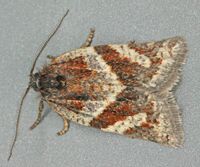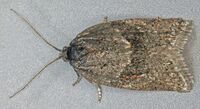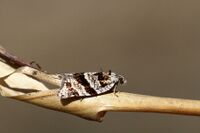Biology:Philedonides lunana
| Philedonides lunana | |
|---|---|

| |
| Illustration from John Curtis's British Entomology Volume 6 | |
| Scientific classification | |
| Domain: | Eukaryota |
| Kingdom: | Animalia |
| Phylum: | Arthropoda |
| Class: | Insecta |
| Order: | Lepidoptera |
| Family: | Tortricidae |
| Genus: | Philedonides |
| Species: | P. lunana
|
| Binomial name | |
| Philedonides lunana (Thunberg, 1784)
| |
| Synonyms | |
|
List
| |
Philedonides lunana, also known as the heath tortrix and Walker’s Lanark tortrix, is a moth of the family Tortricidae. It was first described by Carl Peter Thunberg in 1784 and is found in most of Europe.
Description
There is distinct sexual dimorphism. Males are dull brown and have pectinate (comb-like) antennae. Females have more distinctive chestnut brown markings on a greyish-buff ground colour.[1] The wingspan is 12–16 mm. Adults are on wing from March to May. Males fly on calm, sunny days, especially at sunrise, midday and evening, while females sit on the top of vegetation, where pairing takes place. At other times the moths hide amongst dead leaves and are difficult to find.[2][3]
Eggs are laid in March and April, in small batches on the leaves of coarse, moorland plants. Plants include bearberry (Arctostaphylos uva-ursi species in Ireland), silverweed (Argentina anserina), common mugwort (Artemisia vulgaris), heather (Calluna species), black knapweed (Centaurea nigra), scabiosa species, thistles (Cirsium species), wild carrot (Daucus carota), heath (Erica species), ash (Fraxinus excelsior), petty whin (Genista anglica), larch (Larix species), mint (Mentha species), bog-myrtle (Myrica gale), restharrow (Ononis fruticosa), milk-parsley (Peucedanum palustre), Sitka spruce (Picea sitchensis in Wales), lodgepole pine (Pinus contorta in Scotland and Wales), cinquefoils (Potentilla species), goat willow (Salix caprea), sea campion (Silene uniflora), alexanders (Smyrnium olusatrum), red clover (Trifolium pratense), Vaccinium species and valerians (Valeriana species).[2][4] The larvae feed in spun or folded leaves and flowers in May and June.[2][1] Pupa can be found from June to March, in spun leaves of the foodplant or in debris on the ground.[3]
Distribution
The heath tortrix is found in most of Europe (from Ireland to Russia), with some exceptions, such as the Balkans, France and Iberia. The moth has also been found in the Near East.[5]
References
- ↑ 1.0 1.1 Kimber, Ian. "Philedonides lunana (Thunberg, 1784)". https://ukmoths.org.uk/species/philedonides-lunana/.
- ↑ 2.0 2.1 2.2 Cite error: Invalid
<ref>tag; no text was provided for refs namedbtm - ↑ 3.0 3.1 Emmet, A E, ed (1988). A Field Guide to the Smaller British Lepidoptera (Second ed.). London: British Entomological & Natural History Society. p. 161. ISBN 0 9502891 6 7.
- ↑ Ellis, W N. "Philedonides lunana (Thunberg, 1784) heath tortrix". https://bladmineerders.nl/parasites/animalia/arthropoda/insecta/lepidoptera/ditrysia/apoditrysia/tortricoidea/tortricidae/tortricinae/ramapesiini/philedonides/philedonides-lunana/.
- ↑ "Philedonides lunana (Thunberg, 1784)". https://fauna-eu.org/cdm_dataportal/taxon/98a241e8-f51a-444d-8cf9-82447c8fd29e.
External links
Gallery
Wikidata ☰ Q1766370 entry
 |




